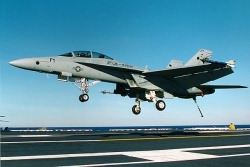|
The F/A-18E/F Super Hornet: A Test Pilot Dispels The Myths By CDR Rob Niewoehner |
||||
|
Myth #2 – "Bigger means faster." Fact – "Bigger means more ordnance, flying farther, staying airborne longer." The F/A-18E/F moldline changes that provide for improved range, payload, and carrier suitability also, however, contribute to a steeper drag rise at transonic speeds, resulting in slightly slower level accelerations to supersonic speeds. A clean (no external stores). Lot XIX C/D will nose out a clean E/F in a drag race from 0.85 to 1.2 at 35,000 ft. But F/A-18E/F subsonic performance in both MIL and MAX power is significantly superior to that of a C/D, and manifests itself in shorter takeoff distances, better climb rates, and faster accelerations. In unloaded, tactically representative accelerations, the two aircraft are indistinguishable. "Apples-to-apples" comparison of the two aircraft must be done cautiously, however. One must remember that the E/F moves the C/D’s ever-present external wing tank fuel into the fuselage and wings. Deploying with a single centerline tank (its projected typical carrier configuration), the E/F’s acceleration performance will be a substantial improvement over a cruise-configured (two fuel tanks on wing stations) C/D everywhere in the flight envelope. Myth #3 – "Then, bigger means less maneuverable." Fact – "In the subsonic regime, the E/F performs as good as or better than a C/D in almost every respect." The challenge posed to the contractor was not to compromise the Hornet’s superb capabilities as a dogfighter. "As good as, or better than..." was the standard to meet. The result is that the turning performance charts overlay one another. At high angles of attack, the E/F’s agility truly shines, with superior roll performance and much more carefree handling. The heritage Hornet was already the stand-out, high angle-of-attack (alpha) machine in the U.S. inventory. The E/F is "hands-down" superior in that environment. As of the end of July, the test program had completed the high-alpha and spin programs on the E-models for all symmetric loads, and on the F-model for fighter and centerline loadings. Lateral asymmetries and F-model stores testing are in progress. There will be no angle-of-attack restrictions for the symmetrically loaded E or F models. Spin characteristics are benign, with a simplified recovery compared with that of the C/D, and no sustained falling-leaf departure exists in any stores loading tested. |
 My last flight in the E/F was in aircraft E4, loaded with three 480-gallon tanks and 4 Mk 83 bombs, and with the center of gravity ballasted to the aft limit of 31.8 percent. In that configuration, the airplane maneuvered without restriction from -30 to +50 degrees AOA, performed zero airspeed tailslides and spins to 120 degrees per second of yaw rate, and unsuccessfully attempted to generate a stable falling-leaf departure. We’ve engineered out all the known departure modes for rolls up to 360 degrees. The air combat maneuvering (ACM) flights have revealed that the airplane may still be maneuvered at speeds as low as 80 KCAS. This airplane will be quite comfortable in any type of a "phone booth" close-in dogfight. Agility, however, should really be considered in terms of the lethality of the complete weapons system. While thrust vectoring is maturing at a pace that might have allowed incorporation into the E/F, the weight and complexity penalties were prohibitive. Instead, adding the Helmet-Mounted Cueing System (HMCS) and a highly maneuverable off-boresight missile (AIM-9X) generates E/F total-system lethality that exceeds that available from a much more agile airplane with current missiles. HMCS and AIM-9X will enter the Fleet in 2001 and 2002, respectively. Myth #4 – "Ninety percent avionics commonality with the C/D means that the E/F is recycling 1970s technology." Fact – "Today’s F/A-18 C/D comes off the production line with a state-of-the-art cockpit and weapon system, thanks to a significant investment in growth since the F/A-18A’s introduction." This actually represents a compelling case for E/F. Go to Part III.
|
|||
|
Copyright © 1997 - 2000 COMBATSIM.COM, INC. All Rights Reserved. Last Updated January 6th, 1999 |
||||
